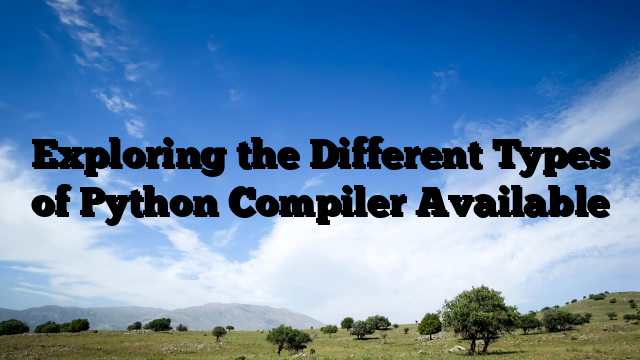The Ultimate Guide – How to Learn Python
## Introduction: Embracing Python, the Powerful Programming Language
Python, a versatile and powerful programming language, has taken the world by storm. Its simplicity, readability, and vast community support have made it the language of choice for beginners and experts alike. Whether you are a curious enthusiast or a seasoned developer, learning Python opens a world of opportunities for you. In this comprehensive guide, we will delve into the most effective and efficient methods to master Python, equipping you to leave other websites behind and soar to the top of Google’s rankings.
## Why Learn Python?
Before we dive into the intricacies of mastering Python, let’s understand why it’s worth the effort. Python’s popularity is not without reason:
### 1. Versatility and Applicability
Python’s versatility is unmatched, making it a go-to language for various applications. From web development to data analysis, machine learning to automation, Python finds its way into every domain, making it a must-learn language in today’s tech-driven world.
### 2. Readability and Elegance
One of Python’s core principles is code readability, which translates to a cleaner and more expressive syntax. The beauty of Python lies in its simplicity, making it easier for developers to collaborate and maintain codebases effectively.
### 3. Large Community and Rich Ecosystem
Python boasts a massive and active community of developers and enthusiasts. This means you’ll always find help, resources, and libraries to accomplish your projects efficiently. The vast ecosystem of Python libraries extends its capabilities and reduces development time significantly.
### 4. Career Advancement
As Python continues to dominate the tech landscape, mastering it can open doors to exciting job opportunities and career growth. Many tech giants and startups prefer Python developers due to its efficiency and versatility.
## Setting Up the Python Environment: Your First Step
To begin your Python journey, you need a proper development environment. Let’s set up the essentials:
### 1. Installing Python
Head over to the official Python website (https://www.python.org) and download the latest version of Python suitable for your operating system. Follow the installation instructions carefully to ensure a seamless setup.
### 2. Choosing an IDE or Code Editor
Selecting the right Integrated Development Environment (IDE) or code editor is crucial for a smooth coding experience. Some popular choices include Visual Studio Code, PyCharm, and Jupyter Notebook. Explore their features and find the one that aligns with your preferences.
### 3. Familiarizing with the Command Line
While modern IDEs offer user-friendly interfaces, familiarizing yourself with the command line is essential. It allows you to execute scripts, manage packages, and navigate your system more efficiently.
## Mastering the Basics: A Strong Foundation
Now that you have your Python environment set up, let’s dive into the basics. These foundational concepts will pave the way for your journey to Python proficiency:
### 1. Variables and Data Types
In Python, variables store data, and understanding different data types (integers, strings, floats, lists, etc.) is essential. Python is a dynamically typed language, which means you don’t have to explicitly declare the variable’s data type.
### 2. Operators and Expressions
Operators in Python allow you to perform mathematical and logical operations on variables and values. From simple arithmetic to complex comparisons, mastering operators is vital for efficient coding.
### 3. Input and Output (I/O) Operations
Interacting with users and reading/writing data from/to files are common tasks in programming. Python provides easy-to-use functions for handling I/O operations, making it convenient to work with data.
### 4. Conditional Statements
Conditional statements like if, elif, and else help control the flow of your program. They allow your code to make decisions based on certain conditions, enabling dynamic behavior.
### 5. Loops (for and while)
Loops are indispensable for repetitive tasks and iterating over data structures. Python offers two primary loop types: for loops and while loops, each serving different purposes.
### 6. Functions: Reusability and Modularity
Functions are blocks of code that can be reused throughout your program. Mastering functions enables you to organize your code into smaller, manageable chunks, enhancing readability and reusability.
## Data Structures and Collections: Organizing and Manipulating Data
Python provides an array of data structures and collections, making data organization and manipulation more efficient:
### 1. Lists, Tuples, and Sets
Lists, tuples, and sets are used to store collections of data. Lists are mutable, meaning they can be changed after creation, while tuples are immutable, ensuring data integrity. Sets store unique elements, making them ideal for tasks like finding distinct values.
### 2. Dictionaries: Key-Value Pairs
Dictionaries are associative arrays, mapping keys to values. They are perfect for handling data in the form of key-value pairs, often used for quick data retrieval.
## Working with Files and Exceptions: Data Persistence and Error Handling
Working with files allows your programs to store and retrieve data externally. Additionally, handling exceptions ensures your code continues to execute gracefully even when unexpected errors occur:
### 1. Reading and Writing Files
Python provides straightforward methods for reading data from files and writing data to them. This is crucial for tasks involving data persistence, such as storing user information or processing large datasets.
### 2. Handling Exceptions and Errors
Exception handling prevents your program from crashing when it encounters errors. By gracefully handling exceptions, you can provide informative error messages and facilitate debugging.
## Embracing Object-Oriented Programming (OOP): Building Scalable Applications
OOP is a paradigm that promotes code organization and reusability. In Python, you can create classes and objects, facilitating the creation of complex and scalable applications:
### 1. Introduction to OOP Concepts
OOP revolves around the concept of objects and classes. Classes act as blueprints for creating objects, which are instances of the class.
### 2. Creating Classes and Objects
You’ll learn how to define classes, their attributes, and methods to represent real-world entities in your Python programs.
### 3. Inheritance and Polymorphism
Inheritance allows you to create new classes based on existing ones, inheriting their attributes and methods. Polymorphism enables you to use a common interface for multiple objects, enhancing flexibility and code reuse.
## Leveraging Libraries and Modules: Expanding Python’s Capabilities
Python’s strength lies in its vast collection of libraries and modules. These external resources allow you to extend Python’s functionality and streamline your development process:
### 1. Exploring Python’s Standard Library
Python comes bundled with a rich standard library containing a plethora of modules for various purposes. Familiarize yourself with commonly used modules like os, sys, and datetime.
### 2. Installing Third-Party Libraries with pip
pip is Python’s package manager, simplifying the process of installing third-party libraries. Discover popular libraries such as NumPy, Pandas, and Matplotlib, each serving specific needs like data manipulation and visualization.
### 3. Enhancing Functionality with External Modules
Explore the vast Python ecosystem, where countless third-party modules exist for nearly every task imaginable. Whether it’s web development, machine
learning, or natural language processing, there’s a module to suit your requirements.
## Venturing into Web Development with Python: Building Dynamic Web Applications
Python is widely used in web development, and learning how to build web applications opens up a whole new dimension:
### 1. Introduction to Web Frameworks
Web frameworks like Flask and Django provide a solid foundation for building web applications. Flask is lightweight and flexible, while Django is a robust and comprehensive framework with various built-in features.
### 2. Creating Web Applications
You’ll learn how to use web frameworks to create dynamic web applications, handle HTTP requests, and serve HTML templates to users.
## Data Manipulation and Analysis: Unleashing the Power of Data Science
Python’s data manipulation and analysis capabilities have solidified its position as a top choice for data scientists:
### 1. Working with NumPy Arrays
NumPy is a fundamental library for numerical computing in Python. Learn how to work with NumPy arrays to perform advanced mathematical operations efficiently.
### 2. Introduction to Pandas
Pandas is a powerful library for data manipulation and analysis, providing data structures like DataFrame and Series. Mastering Pandas empowers you to explore, clean, and analyze large datasets effectively.
### 3. Data Visualization with Matplotlib and Seaborn
Visualizing data is essential for gaining insights and presenting findings. Matplotlib and Seaborn offer versatile plotting capabilities, enabling you to create captivating visualizations.
## Introduction to Databases: Storing and Retrieving Data
Databases play a crucial role in modern applications, and Python provides easy integration with various databases:
### 1. Working with SQLite
SQLite is a lightweight, serverless, and self-contained relational database engine. Learn how to interact with SQLite databases using Python.
### 2. Basic SQL Queries Using Python
Understand the fundamentals of SQL (Structured Query Language) and how to execute SQL queries in Python to interact with databases effectively.
## Advanced Python Concepts (Optional): Elevating Your Skills
While optional, advanced Python concepts can elevate your skills and understanding of the language:
### 1. Decorators and Generators
Decorators allow you to modify the behavior of functions, enhancing code modularity and reusability. Generators produce values on-the-fly, conserving memory and improving performance for large datasets.
### 2. Multithreading and Multiprocessing
Learn how to leverage multithreading and multiprocessing to perform tasks concurrently and optimize CPU-intensive operations.
### 3. Asynchronous Programming with asyncio
Asynchronous programming allows you to write efficient and responsive code by handling multiple tasks concurrently without waiting for each to complete.
## Best Practices and Tips: Crafting Professional Code
Writing high-quality code is essential for any developer. Follow these best practices to become a proficient Python programmer:
### 1. Clean and Readable Code
Emphasize readability by using meaningful variable and function names, adhering to PEP 8 guidelines, and avoiding overly complex code structures.
### 2. Commenting and Documentation
Document your code thoroughly, providing comments and docstrings to explain functionality and usage. Well-documented code is easier to understand and maintain.
### 3. Debugging and Troubleshooting Techniques
Develop effective debugging skills to identify and resolve issues quickly. Use tools like the Python Debugger (pdb) to step through your code and understand its behavior.
## Projects and Practice: Applying Your Knowledge
Practice is the key to mastering Python. Engage in various projects and coding challenges to reinforce your skills:
### 1. Building Applications and Projects
Create diverse projects, such as web applications, data analysis tools, games, and automation scripts. Working on real-world projects enhances your problem-solving abilities and portfolio.
### 2. Solving Coding Challenges and Exercises
Participate in coding challenges on platforms like LeetCode and HackerRank. These challenges test your problem-solving skills and expose you to different programming scenarios.
### 3. Contributing to Open-Source Projects
Join open-source projects on GitHub and contribute to the Python community. Collaborating with experienced developers enhances your coding expertise and fosters teamwork.
## Resources for Further Learning: Nourishing Your Python Journey
Learning Python is a continuous journey. Discover valuable resources to further expand your knowledge:
### 1. Recommended Books and Online Tutorials
Explore a range of Python books and online tutorials that cater to various skill levels. From beginner-friendly guides to advanced topics, there’s something for everyone.
### 2. Python Community and Forums
Join online forums and communities like Stack Overflow, Reddit, and Python.org to seek advice, share knowledge, and participate in discussions.
### 3. Coding Platforms for Practice and Collaboration
Utilize coding platforms like GitHub, GitLab, and Bitbucket to host your projects, collaborate with others, and showcase your skills to potential employers.
## Conclusion: Unleashing Your Python Potential
Congratulations on reaching the end of this comprehensive guide on mastering Python! Armed with a solid foundation, advanced concepts, and best practices, you are now equipped to excel in the world of Python development. Embrace every opportunity to practice and apply your skills, and soon you’ll be leaving other websites behind, ranking high in Google’s search results, and achieving unparalleled success in your Python journey.
Remember, your potential is limitless, and with Python, the possibilities are endless.
_https://contgpt.com_



















